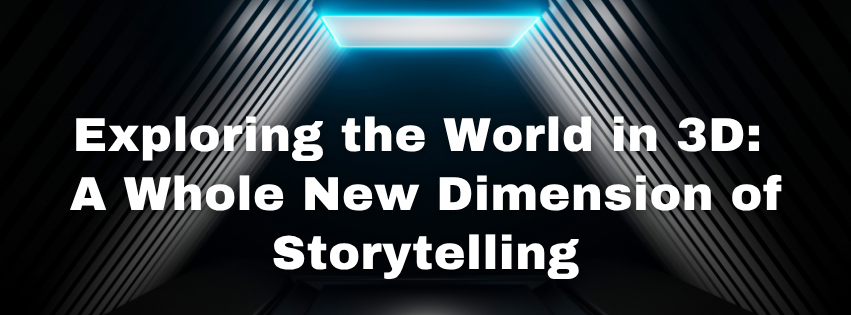
Exploring the World in 3D A Whole New Dimension of Storytelling

Published Date
Are you ready to stop just reading or watching stories and start living them? Forget flat screens and passive viewing — we’re entering an amazing new world where stories leap out in 3D, pulling you right into the heart of the action.
Welcome to 3D storytelling, where your imagination comes alive and you’re not just an audience member but part of the story itself.
What Exactly Is 3D Storytelling?
Think beyond traditional books or movies. 3D storytelling uses incredible three-dimensional visuals, augmented reality (AR), virtual reality (VR), and interactive digital spaces to create immersive, engaging narratives.
Instead of simply looking at a screen, 3D formats place you inside the story. You can explore environments, talk to characters, and even influence what happens next. It’s a huge leap from passive watching to active experiencing — and it’s transforming industries from education and entertainment to marketing and mobile apps.
Why 3D Is Revolutionizing Storytelling
Here’s why brands, teachers, and creators are embracing 3D storytelling:
1. Immersive Experiences Create Greater Engagement
Studies show that immersive 3D experiences build stronger emotional connections. When you feel like you’re actually inside the story — walking around, talking to characters — you engage more deeply and remember it longer.
2. A Powerful Learning Tool for Students
Interactive 3D environments make learning more efficient, effective, and exciting. Imagine exploring a virtual museum, studying ancient civilizations through AR, or visualizing science concepts with 3D models. That’s the power of experiential storytelling.
3. Brand Storytelling Upgraded
Businesses are using 3D storytelling to present products in fresh and interactive ways — from virtual try-ons and 3D demos to branded AR filters. These experiences boost engagement and drive higher conversions.
Apps like PhotoTube.app are leading this shift, enabling businesses and creators to produce 3D-enhanced content without heavy coding or expensive equipment.
How 3D Storytelling Is Transforming Industries
- Entertainment: Movies like Avatar: The Way of Water and VR games such as Half-Life: Alyx showcase the emotional power of immersive 3D visuals.
- Education: Schools and universities are adopting AR/VR to make learning more interactive and memorable.
- Marketing: Brands like IKEA, L’Oréal, and Nike use AR previews and 3D ads to offer virtual trial experiences.
- Medicine: Doctors use 3D simulations for training, diagnostics, and even surgical precision.
- Publishing: Platforms like PhotoTube.app bring books and comics to life with AR layers, turning classic stories into interactive 3D experiences.
3D Narrative Challenges (and How to Overcome Them)
While the potential is vast, 3D storytelling faces challenges such as:
- High production costs
- Technical complexity
- Hardware limitations (especially VR devices)
- Slower adoption among non-tech audiences
However, modern tools like PhotoTube are democratizing the field, allowing anyone to integrate 3D and AR storytelling effortlessly.
The Future of Storytelling
As spatial computing, AI, and AR glasses evolve, the line between real and virtual worlds will fade. We’re moving toward a future where:
- Stories react to your actions
- Experiences blend seamlessly into daily life
- Immersive content is accessible anywhere through wearables
Storytelling will no longer just communicate — it will surround and interact with us.
Conclusion
We’re no longer confined to flat pages or screens. With 3D storytelling, we can walk through imagination, explore ideas, and interact with content like never before.
Whether you’re an educator, brand marketer, creator, or content producer, now is your time to unlock this powerful, immersive new form of storytelling.